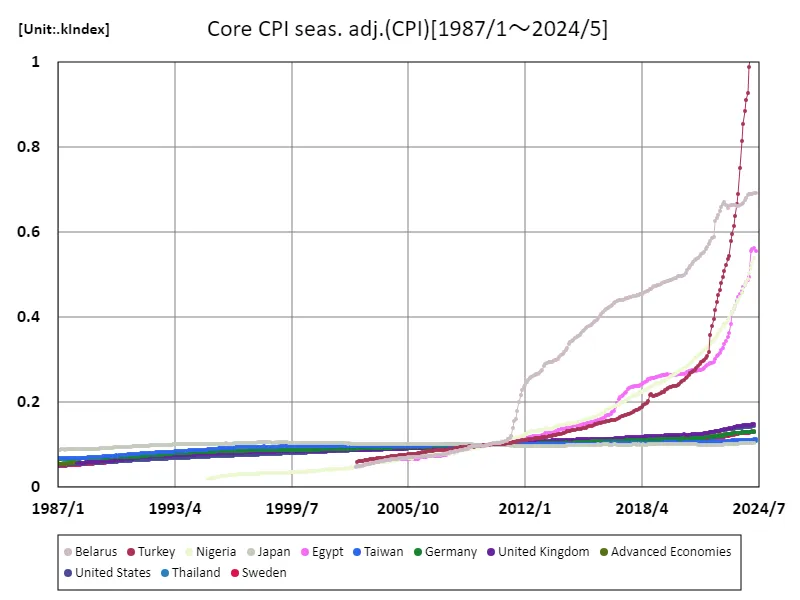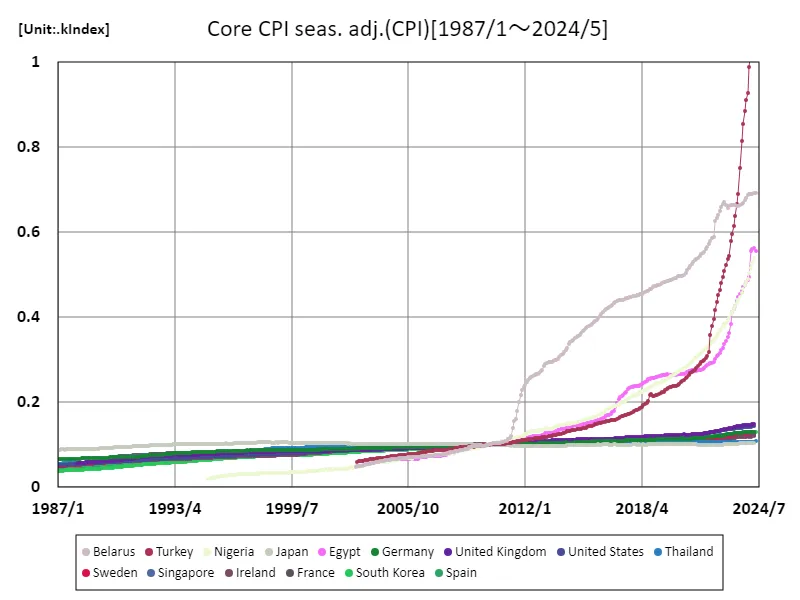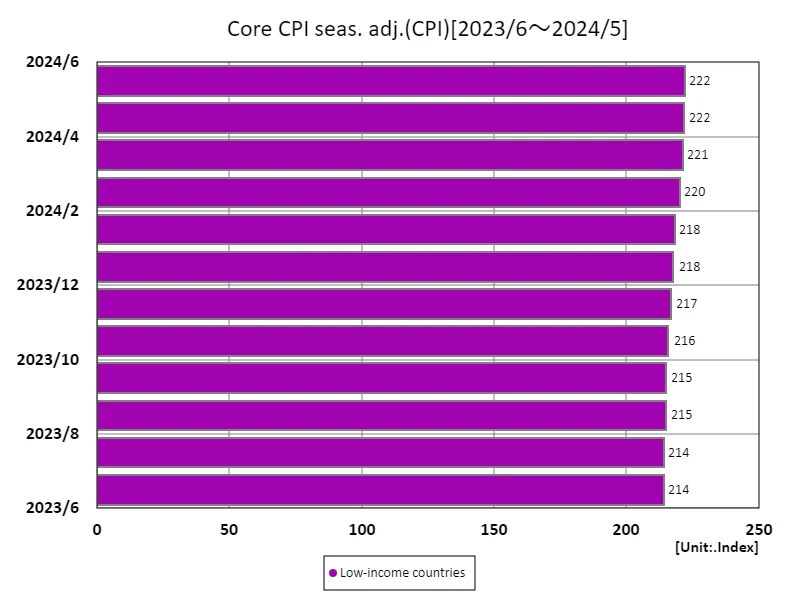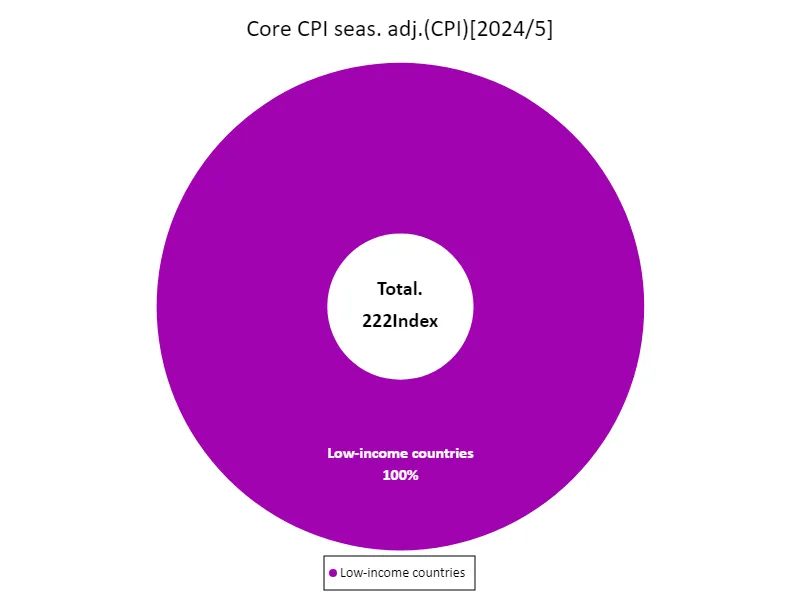- Abstract
- Overall index excluding fresh food (seasonally adjusted)
- Overall index excluding fresh food (seasonally adjusted) (nationwide)
- Overall index excluding fresh food (seasonally adjusted) (by income, latest year)
- Overall index excluding fresh food (seasonally adjusted) (by income, latest year)
- Reference
Abstract
According to data for May 2024, Turkey recorded an index of 1,170 in the overall index (seasonally adjusted) excluding fresh food, attracting attention. Türkiye’s high index should be understood as the result of inflationary forces and economic policies. In recent years, Turkey has been plagued by high inflation rates and the value of its currency has fallen sharply. This has resulted in a surge in prices, with the cost of goods and services, except for fresh foods, increasing sharply. Turkey is also highly dependent on exports, particularly agricultural and industrial product exports, which often affect its economy, but are also subject to external factors and geopolitical risks. Against this background, Türkiye’s overall index is characterized by large fluctuations compared to other countries. Meanwhile, other countries are often experiencing stable economic growth, and in particular developed countries are strengthening policies to curb inflation, which has led to a gradual rise in overall indexes. This makes unique situations like Türkiye’s stand out. Turkey’s economic indicators will also be closely watched as sensitive indicators of international economic conditions and policy decisions.
Overall index excluding fresh food (seasonally adjusted)
It is noteworthy that in the data for the composite index excluding fresh food (seasonally adjusted) from January 1987 to May 2024, Turkey recorded an index of 1,170 in May 2024, reaching 100% compared to the peak. The sharp rise in the index is a direct result of Turkey’s high inflation and sharply depreciating currency, which has placed a strain on consumers, especially the prices of basic goods. Since the 1980s, the Turkish economy has undergone political and economic upheaval, with reforms in particular in the early 2000s stimulating economic growth. However, in recent years, instability in economic policies and external factors have had an impact, leading to rising inflation rates. Especially since the beginning of the 2020s, prices have soared due to disruptions to global supply chains and geopolitical tensions. Turkey’s composite index is significantly higher than other countries, reflecting the fragility of its economic structure. Agricultural and industrial products, which are highly export-dependent, are vulnerable to external market influences, posing a threat to economic stability. As policies for sustainable growth and measures to combat inflation are required in the future, Turkey’s economic indicators will continue to attract international attention.


The maximum is the latest one, 1.17kIndex of Turkey
Overall index excluding fresh food (seasonally adjusted) (nationwide)
In the data for the composite index (seasonally adjusted) excluding fresh food from January 1987 to May 2024, Turkey recorded an index of 1,170 in May 2024, reaching 100% at its peak, which is an important economic indicator. Turkey’s sharp rise in the index is due to a long period of high inflation and a decline in the value of its currency, the lira. Especially since the beginning of the 2020s, disruptions to global supply chains and geopolitical risks have led to a notable surge in prices. Since the liberalization of the 1980s, the Turkish economy has achieved export-dependent growth, but at the same time, it remains vulnerable to instability both domestically and internationally. In particular, rising inflation has made the prices of daily necessities and energy highly susceptible to influence, putting pressure on consumer purchasing power. Compared to other countries’ overall indices, Turkey’s rapid rise is an anomaly, making economic policies even more necessary. As reforms aimed at sustainable economic growth are called for, Turkey’s economic indicators will continue to be closely watched as an important barometer of the international economic situation and the effectiveness of policies.


The maximum is the latest one, 1.17kIndex of Turkey
Overall index excluding fresh food (seasonally adjusted) (by income, latest year)
According to data from June 2023, the composite index (seasonally adjusted) excluding fresh food had a maximum value of 222 in low-income countries, an overall average of 222, and a total of 421. The data reflects the economic situation in low-income countries, suggesting that prices of basic goods and services are rising. Inflationary pressures are particularly pronounced in low-income countries, with rising prices having a major impact on economic activity. These countries are facing rising costs for basic living such as food and energy, while wages are growing slowly, putting increasing pressure on household budgets. External factors, such as climate change and geopolitical tensions, are also affecting supply chains and contributing to price volatility. Moreover, economic indicators in low-income countries highlight their economic fragility and call for policies that promote sustainable growth. International support and investment are essential, and a strategy for long-term development is needed. This will hopefully lead to greater economic stability and improved living standards.


The maximum is the latest one, 222Index of Low-income countries
Overall index excluding fresh food (seasonally adjusted) (by income, latest year)
According to data for May 2024, the Consumer Price Index excluding fresh food (seasonally adjusted) showed an index of 222, the highest among low-income countries, with the average and total also showing a similar index of 222. This homogeneous figure reflects the unique economic circumstances in low-income countries. This situation is closely linked to the high inflation and rising cost of living faced by low-income countries. In particular, prices of daily necessities have skyrocketed while wage growth has been slow, squeezing consumer purchasing power. This is putting pressure on household finances, especially as they spend more on basic needs such as food and energy. In addition, climate change and geopolitical risks also have a significant impact on supply chains, posing a threat to price stability. This makes the Consumer Price Index difficult to predict and forces policymakers to adapt to a rapidly changing economic environment. In order to achieve sustainable growth going forward, international assistance and investment will be essential. Improvements are particularly needed in education and infrastructure, and in the long term a strategy is needed to achieve economic stability and improved living standards. Addressing these challenges is expected to improve the economic health of low-income countries.


The maximum is 222Index of Low-income countries, the average is 222Index, and the total is 222Index



Comments